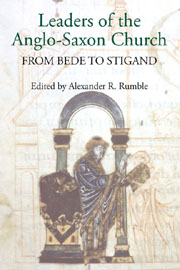Book contents
- Frontmatter
- Contents
- List of Illustrations
- Preface
- Contributors
- Abbreviations
- Introduction: Church Leadership and the Anglo-Saxons
- 1 Bede and the Early English Church
- 2 Archbishop Ecgberht and his Dialogus
- 3 Abbatial Responsibility as Spiritual Labour: Suckling from the Male Breast
- 4 Understanding the Earliest Bishops of Worcester c. 660–860
- 5 The Role of Bishops in Anglo-Saxon Succession Struggles, 955 × 978
- 6 Image-Making: Portraits of Anglo-Saxon Church Leaders
- 7 ‘To Keep Silence Following the Rule's Command’: Bishop Æthelwold, Reforming Ideology and Communication by Signs
- 8 Wulfsige of Sherborne's Reforming Text
- 9 From Winchester to Canterbury: Ælfheah and Stigand – Bishops, Archbishops and Victims
- Index
2 - Archbishop Ecgberht and his Dialogus
Published online by Cambridge University Press: 05 February 2013
- Frontmatter
- Contents
- List of Illustrations
- Preface
- Contributors
- Abbreviations
- Introduction: Church Leadership and the Anglo-Saxons
- 1 Bede and the Early English Church
- 2 Archbishop Ecgberht and his Dialogus
- 3 Abbatial Responsibility as Spiritual Labour: Suckling from the Male Breast
- 4 Understanding the Earliest Bishops of Worcester c. 660–860
- 5 The Role of Bishops in Anglo-Saxon Succession Struggles, 955 × 978
- 6 Image-Making: Portraits of Anglo-Saxon Church Leaders
- 7 ‘To Keep Silence Following the Rule's Command’: Bishop Æthelwold, Reforming Ideology and Communication by Signs
- 8 Wulfsige of Sherborne's Reforming Text
- 9 From Winchester to Canterbury: Ælfheah and Stigand – Bishops, Archbishops and Victims
- Index
Summary
Tempora tunc huius fuerant felicia gentis,
quam rex et praesul concordi iure regebant:
hic iura ecclesiae, rex ille negotia regni.
Hic ab apostolico humeris fert pallia missa,
ille levat capiti veterum diademata patrum.
Fortis hic, ille pius; hic strenuus, ille benignus,
germanae pacis servantes iura vicissim,
ex alio frater felix adiutus uterque.
Rexit hic ecclesiam triginta et quatuor annis,
ille annis tenuit ter septem sceptra parentum;
ambo felices meritis in pace sepulti.
SO Alcuin assessed the central years of the episcopate of Ecgberht of York (bishop c. 732–5, archbishop 735–66) in his Versus de patribus, regibus et sanctis Euboricensis ecclesiae. For all Alcuin's praise of him, Ecgberht remains a little-studied figure. He fits into an obscure and seemingly undistinguished interlude between the Venerable Bede and Alcuin himself and, indeed, Ecgberht is most often explored by scholars only as an adjunct to these two giants of the Anglo-Saxon church; rarely is he considered in his own right. Yet Ecgberht's episcopate was one of the longest of the Anglo-Saxon period and one that saw the re-elevation of York to metropolitan status more than a century after it had first lapsed. Ecgberht himself was a correspondent of Bede and St Boniface and was remembered in England and on the Continent as an expert on canon law and ecclesiastical legislation. Moreover, he was responsible for the early education of Alcuin at York and if he was not the founder of the cathedral school there then at the very least he made it into the kind of institution capable of producing an Alcuin.
- Type
- Chapter
- Information
- Leaders of the Anglo-Saxon ChurchFrom Bede to Stigand, pp. 41 - 60Publisher: Boydell & BrewerPrint publication year: 2012



